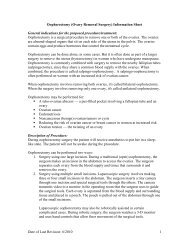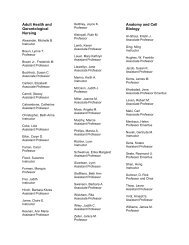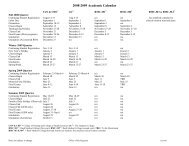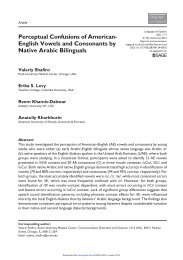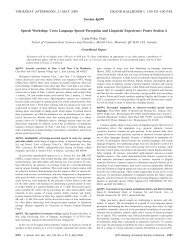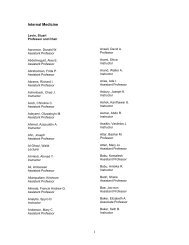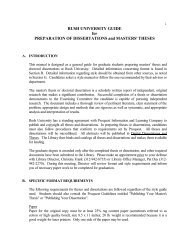Effects of Age and Hearing Loss on the ... - Rush University
Effects of Age and Hearing Loss on the ... - Rush University
Effects of Age and Hearing Loss on the ... - Rush University
You also want an ePaper? Increase the reach of your titles
YUMPU automatically turns print PDFs into web optimized ePapers that Google loves.
10 SHEFT ET AL. / EAR & HEARING, VOL. 00, NO. 00, 000–000<br />
with average audiometric thresholds <str<strong>on</strong>g>and</str<strong>on</strong>g> age ranges <str<strong>on</strong>g>of</str<strong>on</strong>g> HI participants<br />
roughly coinciding with those <str<strong>on</strong>g>of</str<strong>on</strong>g> <strong>the</strong> older HI subject<br />
group <str<strong>on</strong>g>of</str<strong>on</strong>g> <strong>the</strong> present work. Between <strong>the</strong> younger NH <str<strong>on</strong>g>and</str<strong>on</strong>g> older<br />
HI listeners, <strong>the</strong> average SRT increased by 7.9 dB in <strong>the</strong> study<br />
<str<strong>on</strong>g>of</str<strong>on</strong>g> Wils<strong>on</strong> et al. as compared with <strong>the</strong> 5.25 change in SNR <str<strong>on</strong>g>Loss</str<strong>on</strong>g><br />
in <strong>the</strong> present work.<br />
Al<strong>on</strong>g with its effect <strong>on</strong> SNR <str<strong>on</strong>g>Loss</str<strong>on</strong>g>, hearing loss was associated<br />
with a shallower slope <str<strong>on</strong>g>of</str<strong>on</strong>g> <strong>the</strong> speech-intelligibility functi<strong>on</strong>.<br />
At <strong>the</strong> 50% correct point, both younger <str<strong>on</strong>g>and</str<strong>on</strong>g> older NH listeners<br />
showed a mean slope <str<strong>on</strong>g>of</str<strong>on</strong>g> approximately 14% per dB <str<strong>on</strong>g>of</str<strong>on</strong>g> SNR,<br />
whereas <strong>the</strong> mean slope for <strong>the</strong> older HI participants was 10%<br />
per dB. This difference in slope agrees well with <strong>the</strong> 6.1% per<br />
dB difference reported by Wils<strong>on</strong> et al. (2007) between comparable<br />
subject groups. In general, a decrease in <strong>the</strong> psychometricfuncti<strong>on</strong><br />
slope indicates an increase in processing variance from<br />
ei<strong>the</strong>r noise or distorti<strong>on</strong>. Plomp (1978) argued that hearing<br />
impairment shows combined effects <str<strong>on</strong>g>of</str<strong>on</strong>g> attenuati<strong>on</strong> <str<strong>on</strong>g>and</str<strong>on</strong>g> distorti<strong>on</strong>.<br />
As with speech percepti<strong>on</strong>, distorti<strong>on</strong> in auditory processing<br />
would impair <strong>the</strong> ability to discriminate FM stimuli. Results<br />
showed that <strong>the</strong> effect <str<strong>on</strong>g>of</str<strong>on</strong>g> hearing loss was not significant in <strong>the</strong><br />
FM measures obtained from <strong>the</strong> older participants, suggesting<br />
that possible distorti<strong>on</strong> associated with hearing loss was not a<br />
factor affecting psychoacoustic results from <strong>the</strong>se listeners. It<br />
thus seems that possible involvement <str<strong>on</strong>g>of</str<strong>on</strong>g> distorti<strong>on</strong> in <strong>the</strong> Quick-<br />
SIN results <str<strong>on</strong>g>of</str<strong>on</strong>g> <strong>the</strong> older HI listeners does not reflect a change in<br />
<strong>the</strong> overall processing ability <str<strong>on</strong>g>of</str<strong>on</strong>g> low-rate stochastic FM.<br />
Results showed a significant correlati<strong>on</strong> between performance<br />
in <strong>the</strong> SNR FM<br />
c<strong>on</strong>diti<strong>on</strong> <str<strong>on</strong>g>and</str<strong>on</strong>g> masked speech percepti<strong>on</strong><br />
as measured by QuickSIN SNR <str<strong>on</strong>g>Loss</str<strong>on</strong>g>. For young-to-middleaged<br />
listeners who varied in degrees <str<strong>on</strong>g>of</str<strong>on</strong>g> hearing loss, Buss et<br />
al. (2004) reported significant correlati<strong>on</strong>s between speech<br />
percepti<strong>on</strong> <str<strong>on</strong>g>and</str<strong>on</strong>g> measures <str<strong>on</strong>g>of</str<strong>on</strong>g> 2-Hz FM detecti<strong>on</strong>. For a subject<br />
group composed <str<strong>on</strong>g>of</str<strong>on</strong>g> primarily older HI listeners, Strelcyk <str<strong>on</strong>g>and</str<strong>on</strong>g><br />
Dau (2009) found that speech recepti<strong>on</strong> in <strong>the</strong> presence <str<strong>on</strong>g>of</str<strong>on</strong>g> a<br />
two-talker babble masker was significantly correlated with<br />
2-Hz FM detecti<strong>on</strong> in which low-rate amplitude modulati<strong>on</strong><br />
was also imposed <strong>on</strong> <strong>the</strong> stimulus carrier. Working with both<br />
young <str<strong>on</strong>g>and</str<strong>on</strong>g> older NH <str<strong>on</strong>g>and</str<strong>on</strong>g> HI listeners, Hopkins <str<strong>on</strong>g>and</str<strong>on</strong>g> Moore<br />
(2011) found a significant relati<strong>on</strong>ship between SRTs in modulated<br />
noise <str<strong>on</strong>g>and</str<strong>on</strong>g> <strong>the</strong> ability to discriminate between complex<br />
t<strong>on</strong>es that differed <strong>on</strong>ly in terms <str<strong>on</strong>g>of</str<strong>on</strong>g> temporal fine structure but<br />
not envelope. The relati<strong>on</strong>ship between speech percepti<strong>on</strong> <str<strong>on</strong>g>and</str<strong>on</strong>g><br />
temporal fine-structure processing has also been evaluated in<br />
studies that measured <strong>the</strong> intelligibility <str<strong>on</strong>g>of</str<strong>on</strong>g> speech stimuli processed<br />
to c<strong>on</strong>trol fine-structure cues. Lorenzi et al. (2006),<br />
Hopkins et al. (2008), <str<strong>on</strong>g>and</str<strong>on</strong>g> Ardoint et al. (2010) showed that <strong>the</strong><br />
ability to use <strong>the</strong> temporal fine-structure cues <str<strong>on</strong>g>of</str<strong>on</strong>g> speech was<br />
reduced or abolished in most listeners with a mild-to-moderate<br />
cochlear hearing loss irrespective <str<strong>on</strong>g>of</str<strong>on</strong>g> age, although younger listeners<br />
tended to show better ability to use <strong>the</strong>se cues than did<br />
older listeners. HI listeners showing best speech intelligibility<br />
in a n<strong>on</strong>stati<strong>on</strong>ary noise background also showed residual ability<br />
to use temporal fine-structure speech cues (Lorenzi et al.<br />
2006). Individual differences in this residual ability accounted<br />
for approximately 70% <str<strong>on</strong>g>of</str<strong>on</strong>g> <strong>the</strong> variance in speech-intelligibility<br />
scores in fluctuating noise. If <strong>the</strong> c<strong>on</strong>tributi<strong>on</strong> <str<strong>on</strong>g>of</str<strong>on</strong>g> temporal<br />
fine-structure cues to speech percepti<strong>on</strong> is most evident in<br />
masking c<strong>on</strong>diti<strong>on</strong>s, present results suggest that <strong>the</strong> difficulty<br />
experienced by older listeners with speech-in-noise processing<br />
may in part relate to diminished ability to process slower finestructure<br />
modulati<strong>on</strong> at low SNRs.<br />
In summary, results indicate that measures <str<strong>on</strong>g>of</str<strong>on</strong>g> stochastic FM<br />
processing show effects <str<strong>on</strong>g>of</str<strong>on</strong>g> listener age. Am<strong>on</strong>g older listeners<br />
with up to a moderate hearing loss, <strong>the</strong> degree <str<strong>on</strong>g>of</str<strong>on</strong>g> loss did not<br />
significantly affect performance. Fur<strong>the</strong>rmore, <strong>the</strong> relati<strong>on</strong>ship<br />
between <strong>the</strong> QuickSIN performance <str<strong>on</strong>g>and</str<strong>on</strong>g> <strong>the</strong> SNR FM<br />
thresholds<br />
suggests that an FM-processing deficit may hinder speechin-noise<br />
intelligibility. Most hearing aids include some form<br />
<str<strong>on</strong>g>of</str<strong>on</strong>g> amplitude compressi<strong>on</strong> to restrict dynamic range. The<br />
analysis by Sheft et al. (2008) c<strong>on</strong>ducted with vocoded speech<br />
signals dem<strong>on</strong>strated that any alterati<strong>on</strong> in <strong>the</strong> fidelity <str<strong>on</strong>g>of</str<strong>on</strong>g> temporal–envelope<br />
transmissi<strong>on</strong> also affects <strong>the</strong> fidelity <str<strong>on</strong>g>of</str<strong>on</strong>g> temporal<br />
fine-structure transmissi<strong>on</strong>. This suggests str<strong>on</strong>gly that though<br />
hearing-aid compressi<strong>on</strong> is set by temporal–envelope values, it<br />
affects <strong>the</strong> fidelity <str<strong>on</strong>g>of</str<strong>on</strong>g> transmissi<strong>on</strong> <str<strong>on</strong>g>of</str<strong>on</strong>g> <strong>the</strong> temporal fine-structure<br />
cues <str<strong>on</strong>g>of</str<strong>on</strong>g> speech. Correlati<strong>on</strong>s obtained in <strong>the</strong> present study<br />
indicate that evaluati<strong>on</strong> <str<strong>on</strong>g>of</str<strong>on</strong>g> hearing-aid compressi<strong>on</strong> algorithms<br />
needs to c<strong>on</strong>sider impact <strong>on</strong> <strong>the</strong> FM <str<strong>on</strong>g>of</str<strong>on</strong>g> speech. Present work is<br />
developing a clinically feasible approach for assessment <str<strong>on</strong>g>of</str<strong>on</strong>g> <strong>the</strong><br />
SNR measure <str<strong>on</strong>g>of</str<strong>on</strong>g> stochastic FM processing. In additi<strong>on</strong> to <str<strong>on</strong>g>of</str<strong>on</strong>g>fering<br />
a fuller picture <str<strong>on</strong>g>of</str<strong>on</strong>g> <strong>the</strong> auditory difficulties experienced in an<br />
adverse noisy envir<strong>on</strong>ment, <strong>the</strong> procedure will potentially help<br />
in determining appropriate settings for pros<strong>the</strong>tic devices <str<strong>on</strong>g>and</str<strong>on</strong>g> in<br />
m<strong>on</strong>itoring rehabilitati<strong>on</strong> progress.<br />
ACKNOWLEDGMENTS<br />
The authors thank Erica Hegl<str<strong>on</strong>g>and</str<strong>on</strong>g> for her assistance with data collecti<strong>on</strong>.<br />
This work was supported by <strong>the</strong> Nati<strong>on</strong>al Organizati<strong>on</strong> For <str<strong>on</strong>g>Hearing</str<strong>on</strong>g><br />
Research Foundati<strong>on</strong> <str<strong>on</strong>g>and</str<strong>on</strong>g> Nati<strong>on</strong>al Institutes <str<strong>on</strong>g>of</str<strong>on</strong>g> Health-Nati<strong>on</strong>al Institute<br />
<strong>on</strong> Deafness <str<strong>on</strong>g>and</str<strong>on</strong>g> O<strong>the</strong>r Communicati<strong>on</strong> Disorders (R15 DC011916 <str<strong>on</strong>g>and</str<strong>on</strong>g><br />
R03 DC008676). The c<strong>on</strong>tent is solely <strong>the</strong> resp<strong>on</strong>sibility <str<strong>on</strong>g>of</str<strong>on</strong>g> <strong>the</strong> authors <str<strong>on</strong>g>and</str<strong>on</strong>g><br />
does not necessarily represent <strong>the</strong> <str<strong>on</strong>g>of</str<strong>on</strong>g>ficial views <str<strong>on</strong>g>of</str<strong>on</strong>g> <strong>the</strong> Nati<strong>on</strong>al Institute <strong>on</strong><br />
Deafness <str<strong>on</strong>g>and</str<strong>on</strong>g> O<strong>the</strong>r Communicati<strong>on</strong> Disorders or <str<strong>on</strong>g>of</str<strong>on</strong>g> <strong>the</strong> Nati<strong>on</strong>al Institutes<br />
<str<strong>on</strong>g>of</str<strong>on</strong>g> Health. The authors have no c<strong>on</strong>flicts <str<strong>on</strong>g>of</str<strong>on</strong>g> interest to disclose.<br />
Address for corresp<strong>on</strong>dence: Stanley Sheft, Communicati<strong>on</strong> Disorders<br />
<str<strong>on</strong>g>and</str<strong>on</strong>g> Sciences, <strong>Rush</strong> <strong>University</strong> Medical Center, 1015 AAC, 600 S. Paulina<br />
Street, Chicago, IL 60612, USA. E-mail: stanley_sheft@rush.edu<br />
Received March 20, 2011; accepted April 11, 2012.<br />
REFERENCES<br />
ANSI. (2004). Specificati<strong>on</strong>s for Audiometers (ANSI S3.6-2004). New York,<br />
NY: ANSI.<br />
Anstis, S., & Saida, S. (1985). Adaptati<strong>on</strong> to auditory streaming <str<strong>on</strong>g>of</str<strong>on</strong>g><br />
frequency-modulated t<strong>on</strong>es. J Exp Psych Human Percept Perf, 11,<br />
257–271.<br />
Ardoint, M., Sheft, S., Fleuriot, P., et al. (2010). Percepti<strong>on</strong> <str<strong>on</strong>g>of</str<strong>on</strong>g> temporal finestructure<br />
cues in speech with minimal envelope cues for listeners with<br />
mild-to-moderate hearing loss. Int J Audiol, 49, 823–831.<br />
Binns, C., & Culling, J. F. (2007). The role <str<strong>on</strong>g>of</str<strong>on</strong>g> fundamental frequency c<strong>on</strong>tours<br />
in <strong>the</strong> percepti<strong>on</strong> <str<strong>on</strong>g>of</str<strong>on</strong>g> speech against interfering speech. J Acoust Soc<br />
Am, 122, 1765–1776.<br />
Bregman, A. (1990). Auditory Scene Analysis. Cambridge, MA: MIT Press.<br />
Buss, E., Hall, J. W., III, Grose, J. H. (2004). Temporal fine-structure cues to<br />
speech <str<strong>on</strong>g>and</str<strong>on</strong>g> pure t<strong>on</strong>e modulati<strong>on</strong> in observers with sensorineural hearing<br />
loss. Ear Hear, 25, 242–250.<br />
CHABA. (1988). Speech underst<str<strong>on</strong>g>and</str<strong>on</strong>g>ing <str<strong>on</strong>g>and</str<strong>on</strong>g> aging. J Acoust Soc Am, 83,<br />
859–895.<br />
Clinard, C. G., Tremblay, K. L., Krishnan, A. R. (2010). Aging alters <strong>the</strong><br />
percepti<strong>on</strong> <str<strong>on</strong>g>and</str<strong>on</strong>g> physiological representati<strong>on</strong> <str<strong>on</strong>g>of</str<strong>on</strong>g> frequency: Evidence<br />
from human frequency-following resp<strong>on</strong>se recordings. Hear Res, 264,<br />
48–55.<br />
Collins, L. M., Wakefield, G. H., Feinman, G. R. (1994). Temporal pattern<br />
discriminati<strong>on</strong> <str<strong>on</strong>g>and</str<strong>on</strong>g> speech recogniti<strong>on</strong> under electrical stimulati<strong>on</strong>. J<br />
Acoust Soc Am, 96(5 Pt 1), 2731–2737.<br />
Copyright © Lippincott Williams & Wilkins. Unauthorized reproducti<strong>on</strong> <str<strong>on</strong>g>of</str<strong>on</strong>g> this article is prohibited.



